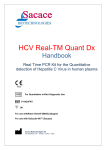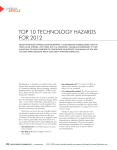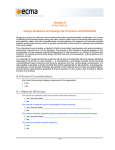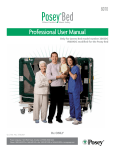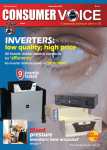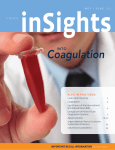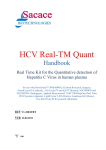Download THE FOOD AND DRUG ADMINISTRATION (FDA) UPDATES
Transcript
Insights is now avaiable online at www.COLAcentral.com and www.COLA.org Insights JULY / august ‘10 The Food and Drug Administration (FDA) Updates From: http://www.fda.gov/ForConsumers/ByAudience/ ForPatientAdvocates/HIVandAIDSActivities/default.htm “The Food and Drug Administration (FDA), is a regulatory agency that enforces the Food, Drug, and Cosmetic Act and the Public Health Service Act, assuring that drugs and biologics are safe and effective for their intended uses, and properly labeled. FDA’s activities help protect all consumers in the United States, regulating some trillion dollars worth of products. The FDA sets standards for, and monitors: • all prescription and non-prescription drugs; • all blood products, vaccines, and tissues for transplantation; • all medical devices and equipment, and all radiation emitting devices; • all animal drugs and feed; • nearly all domestic and imported foods except for meat and poultry; • and all cosmetics.” Because of this, the FDA plays a major role in the personal and professional lives of all medical laboratory professionals. The following articles highlight a few examples of this impact. FDA Approves Rapid Test for Antibodies to Hepatitis C Virus For Immediate Release: June 25, 2010 Consumer Inquiries: 888-INFO-FDA The U.S. Food and Drug Administration today announced approval of the first rapid blood test for antibodies to the hepatitis C virus (HCV) for individuals 15 years and older. The OraQuick HCV Rapid Antibody Test is used to test individuals who are at risk for infection with HCV and people with signs or symptoms of hepatitis. HCV is transmitted through exposure to infected blood, which, for example, can occur during intravenous drug use. The virus can also be transferred from an infected mother to her child. Hepatitis C can lead to liver inflammation and dysfunction and, over time, to liver disease and liver cancer. OraQuick is a test strip and does not require an instrument for diagnosis. It takes about 20 minutes to obtain results from the test. “Approval of OraQuick means that more patients can be notified of their HCV infection faster so that they can consult with their physicians for appropriate health measures,” said Jeffrey Shuren, M.D., J.D., director of the FDA’s Center for Devices and Radiological Health. “Getting faster treatment is an important public health step to control this dangerous disease.” OraQuick is not approved for HCV screening of the general population. According to the U.S. Centers for Disease Control and Prevention, there are approximately 3.2 million people in the United States chronically infected with HCV continued on page 2 9881 Broken Land Parkway, Suite 200 | Columbia, MD | 21046-1195 www.cola.org | www.LabUniversity.org | www.COLAcentral.com july / Au g u s t ‘ 10 Insights From the Chair COLA Information Resource Center 800.981.9883 www.cola.org | www.LabUniversity.org | www.COLAcentral.com and each year, about 17,000 people are newly infected. Chronic HCV infection is a leading reason for a liver transplant in the United States and HCV is associated with an estimated 12,000 deaths annually. Approximately 75 to 85 percent of people who become infected with the hepatitis C virus develop chronic infection. the diagnostic setting detect HIV antibodies only. Although direct detection of the virus itself by nucleic acid testing is available, it is not widely used in diagnostic settings. OraQuick is manufactured by Bethlehem, PA-based OraSure Technologies Inc. This issue of Insights includes press releases from the FDA regarding approval of new test assays that might prove useful in your laboratory, and recall notices about automatic external defibrillators (AED). Although AEDs are not confined to laboratory use, we felt we had to include this information as a precautionary measure to avoid potential serious adverse events. Article reprinted from: http://www.fda.gov/NewsEvents/Newsroom/ PressAnnouncements/ucm217318.htm See website for more information. Finally, the notice of fines imposed upon the American Red Cross Blood Services stresses the importance of identifying, investigating, resolving and documenting problems within the lab as they occur. For help addressing problems as they occur, you could refer to any installment of the recently concluded series which focused on Occurrence Management. As always, our goal is to help you provide quality care to your patients. Please share your questions and comments with us so that we can share your knowledge with the rest of the COLA community. 2 Verlin K. Janzen, MD, FAAFP Chair, COLA Board of Directors Insights The Food and Drug Administration (FDA) Updates continued from page 2 For more information: We’ll continue to highlight lab medicine innovations at our next Symposium. Join us in Scottsdale, AZ in September. july / Au g u s t ‘ 10 The Food and Drug Administration (FDA) Updates continued from page 1 Just as the fireworks burst in the air over the July 4th weekend, innovations are bursting on the scene of laboratory medicine. So, this seemed like the appropriate time to share a few of these advances with you. An article about a novel approach to decreasing hospital-acquired (nosocomial) infections reinforces the patient safety theme from the last edition of Insights. COLA Information Resource Center 800.981.9883 www.cola.org | www.LabUniversity.org | www.COLAcentral.com • FDA: Medical Devices: http://www.fda.gov/MedicalDevices/ default.htm • NIH: Hepatitis C: http://health.nih.gov/topic/HepatitisC FDA Approves First Diagnostic Assay to detect both HIV Antigen and Antibodies For Immediate Release: June 21, 2010 Consumer Inquiries: 888-INFO-FDA Test advances ability to detect HIV infection earlier The U.S. Food and Drug Administration today approved the first assay to detect both antigen and antibodies to Human Immunodeficiency Virus (HIV). This assay is approved for use as an aid in the diagnosis of HIV-1/HIV-2 infection in adults including pregnant women. It is also the first assay for use as an aid in the diagnosis of HIV-1/HIV-2 infection in children as young as two years old. The highly sensitive assay is intended to be used as an aid in the diagnosis of HIV-1/HIV-2 infection, including acute or primary HIV-1 infection. Since it actually detects the HIV-1 virus (specifically the p24 antigen) in addition to antibodies to HIV, the ARCHITECT HIV Ag/Ab Combo assay can be used to diagnose HIV infection prior to the emergence of antibodies. Most tests used today in continued on page 3 COLA Insights COLA is sponsored by the American Academy of Family Physicians (AAFP), the American Medical Association (AMA), the American Osteopathic Association (AOA), and the American College of Physicians (ACP); and is endorsed by 29 national and state medical organizations. Letters to the editor are welcome. Advertising Policy COLA accepts advertising requests for inclusion in it’s publications. All advertisements are subject to review and approval by COLA. COLA reserves the right to reject or cancel any advertisement that is not in keeping with COLA’s standards as a national accreditation organization and it’s publication standards. COLA and it’s publications do not and will not endorse, directly or indirectly, any advertiser’s products or services. If you would like to discuss advertising opportunities, please contact COLA at 410.381.6581, ext. 368. © COLA 2010. COLA INSIGHTS is published periodically by COLA, 9881 Broken Land Parkway, Suite 200, Columbia, MD 21046-1195. COLA INFORMATION RESOURCE CENTER: 800.981.9883. This publication may be obtained through enrollment in a COLA accreditation program, or by subscription for $48 per year. ALL RIGHTS RESERVED. Reproduction in whole or in part without written permission is prohibited. HIV is the virus that can lead to acquired immune deficiency syndrome, or AIDS. HIV damages a person’s body by destroying specific blood cells, called CD4+ T cells, which are crucial to helping the body fight diseases. Two types of HIV have been identified: HIV-1 and HIV-2. HIV-1 is responsible for most HIV infections throughout the world. HIV-2 is found primarily in West Africa; however, cases of HIV-2 infection have been reported in North America and Europe. The Centers for Disease Control and Prevention report that approximately 18 million people in the United States are tested for HIV each year. Most recent CDC estimates are that there are about 56,000 new HIV infections in the United States each year. In addition, there are more than 1 million people living with HIV in the United States, according to CDC. “The approval of this assay represents an advancement in our ability to better diagnose HIV infection in diagnostic settings where nucleic acid testing to detect the virus itself is not routinely used,” said Karen Midthun, M.D., acting director of FDA’s Center for Biologics Evaluation and Research. “It provides for more sensitive detection of recent HIV infections compared with antibody tests alone.” The ARCHITECT HIV Ag/Ab Combo assay is not intended to be used for routine screening of blood donors. However, it is approved as a donor screening assay for HIV-1/HIV-2 infection in urgent situations where licensed blood donor screening tests are unavailable or their use is impractical. The ARCHITECT HIV Ag/Ab Combo assay will be used in clinical laboratories and in public health laboratories, and is the first assay approved in the United States to detect HIV antigen and antibodies simultaneously. The ARCHITECT HIV Ag/Ab Combo assay is manufactured by Abbott Laboratories, Abbott Park, IL. For more information: • HIV Testing: http://www.fda.gov/ForConsumers/ ByAudience/ForPatientAdvocates/ HIVandAIDSActivities/ucm117922.htm • HIV and AIDS Activities: http://www.fda.gov/ ForConsumers/ByAudience/ForPatientAdvocates/ HIVandAIDSActivities/default.htm Article reprinted from: http://www.fda.gov/NewsEvents/ Newsroom/PressAnnouncements/ucm216375.htm See website for more information. Defibtech LLC, DBP-2800 Battery Pack for ReviveR AED™ and Lifeline AED® Semi-automatic External Defibrillators Recall Class: Class I Date Recall Initiated: May 21, 2010 Product(s): DBP-2800 Battery Pack for the Defibtech ReviveR AED™ and Lifeline AED® semi-automatic external defibrillators Affects only DBP-2800 battery packs distributed prior to June 4, 2007 and used with the ReviveR AED™ and Lifeline AED® devices. Affected battery pack serial numbers range: • Between 202001005 and 202005916, or, • Between 206001001 and 206009871 In a letter to customers dated May 20, 2010, Defibtech states that the company is mailing to all affected customers a battery pack update data card that will allow customers to update device software to correct the problem while allowing the devices to remain in their locations. To view the Defibtech notification and instructions on determining whether a battery pack is affected visit http://www.defibtech.com/BatteryFA-usa.html Reason for Recall: If the AED is used with an affected battery pack, the AED may falsely detect an error condition, cancel charge and not provide therapy. Recalling Firm: Defibtech LLC 741 Boston Post Road, Suite 201 Guilford, Connecticut 06483-3921 continued on page 4 3 july / Au g u s t ‘ 10 Insights The Food and Drug Administration (FDA) Updates continued from page 3 Public Contact: Defibtech Technical Support at [email protected] or call 1-877-453-4507 or 1-203-453-4507, 8:30 A.M. to 5:00 P.M. (Eastern Time), Monday - Friday. FDA Comments: The following are Defibtech’s immediate recommendations • Determine if your battery pack is affected by this correction by following the steps on the company website. • If your battery pack is affected by this correction, keep your DDU-100 series AED and battery in service until you have received your battery pack update card from Defibtech and have updated your battery pack. Make sure that you have a replacement battery pack available, and arrange for a backup AED if you do not have a replacement battery pack available. • If during a rescue, your AED cancels shock and shuts down with a service code 1003, replace the battery pack and proceed with the rescue. If this condition occurs, the AED containing an affected DBP-2800 battery pack will announce “Shock Cancelled”, “Service Code 1003”, “Powering Off”. • If your battery pack is not affected by this correction, keep your DDU-100 series AED and battery in service and maintain it in accordance with the User Manual. Article reprinted from: http://www.fda.gov/MedicalDevices/ Safety/RecallsCorrectionsRemovals/ListofRecalls/ ucm215407.htm See website for more information. Physio-Control Inc., LIFEPAK 20 and LIFEPAK 20e External Defibrillator/Monitors Recall Class: Class I Date Recall Initiated: May 27, 2010 Product(s): LIFEPAK 20 and LIFEPAK 20e External Defibrillator/Monitors To view the Physio-Control notification and instructions to search for affected devices by serial number visit http://www.physio-control-notices.com/notice_home. aspx?pid=95 The serial number is located on the underside of the device and contains only numbers. COLA Information Resource Center 800.981.9883 www.cola.org | www.LabUniversity.org | www.COLAcentral.com Approximately 42,943 devices were distributed worldwide between September 16, 2002 and September 27, 2007. These devices were manufactured from July 31, 2002 to September 19, 2007. Recalling Firm: Physio-Control, Inc. 11811 Willows Road NE Redmond, Washington 98052-2003 Reason for Recall: A failure on the power supply assembly can result in either “No DC power” or “No DC or AC power”. A failure of DC (battery) power can result in the inability to deliver defibrillation therapy if the device will not turn on using DC (battery) power and no AC (line) power is available. Public Contact: Physio-Control Technical Support at [email protected] or call 1-800-442-1142, Monday – Friday between 6:00 A.M. and 4:00 P.M. (Pacific Time). FDA Comments: The firm began mailing notification letters to affected customers on May 26, 2010. All affected power supplies will be updated. Customers are advised to keep the defibrillators in service and follow recommended daily Operator Checklist steps while service updates are scheduled. Useful Links: • LIFEPAK 20 and LIFEPAK 20e daily Operator Checklist: http://www.physio-control-notices.com(S(fnmiysq5bi 1tkcmwnfmmgy55))/resources.aspx?pid=95 Article reprinted from: http://www.fda.gov/MedicalDevices/ Safety/RecallsCorrectionsRemovals/ListofRecalls ucm217933.htm See website for more information. COLA Information Resource Center 800.981.9883 www.cola.org | www.LabUniversity.org | www.COLAcentral.com Increasing Patient Safety by Decreasing Hospital-acquired Infections july / Au g u s t ‘ 10 Insights results before advocating changes in dress code policies. It also reaffirms existing AMA policy urging the adoption of hand-washing as an important patient safety priority. Whether or not clothing is a major means of transmission of nosocomial infection, steps have already been taken to combat this form of bacterial spread. The PR Newswire article mentions the creation of lab coats and scrubs “Lab coats or scrubs can be the source of some serious “embedded with Tri-Active, an FDA approved silver-based bacterial hazards like MRSA,” said Charles P. Gerba, PhD, antimicrobial compound that can kill resistant microa professor of Environmental Microbiology in the organisms such as MRSA, E. coli and Salmonella.” Department of Microbiology and Immunology at the University of Arizona. “When doctors or nurses lean over An alternative approach, mentioned in an article on the the beds of patients who are carrying organisms, their AMA website, is clothing that “when washed in bleach, clothing can become contaminated. Hours later that maintains the chlorine until the next wash, continually bacteria can still be alive and passed on through incidental working to kill bacteria.”� This article also mentions other possible transmission vehicles: the stethoscope and cell contact with other patients.”1 phone, as well as the invention of sterile or anti-bacterial The article mentioned recent studies done at the University covers for both. of Maryland and Virginia Commonwealth University, but the American Medical Association (AMA) feels more See the following sites for more information: studies should be conducted. According to a report 1 http://www.prnewswire.com/news-releases/ama-weighs-infecissued by the AMA Board of Trustees, better hygiene, not tion-hazard-posed-by-medical-clothing-96784634.html dress codes, appears to provide the greatest hope in 2 http://www.ama-assn.org/amednews/2010/06/28/prsn0628.htm reducing hospital-acquired-infections. The AMA report 3 http://www.ama-assn.org/amednews/2010/06/07/bisc0607.htm encourages more research and validation of the research A recent article� (released by PR Newswire) documented how infections may be spread via lab coats and scrubs worn by medical personnel. Correction: In the May/Jun 10 edition of Insights, there was an inadvertent omission in the “Occurrence Management” article. According to CLIA requirements, “the test report date” is another key element that must be included on the final test report. Please note: The collection date, the testing date and the test report date are all required as part of a complete test record. A listing of all elements required by CLIA to be on the test report can be found in subpart K, sec 493.1291 at the following link: http://wwwn.cdc.gov/clia/regs/subpart_k. aspx#493.1291 Class 1 recalls are the most serious type of recall and involve situations in which there is a reasonable probability that use of these products will cause serious adverse health consequences or death. Health care professionals and consumers may report adverse reactions or quality problems they experienced using these products to the FDA’s MedWatch Adverse Event Reporting program either online, by regular mail or by FAX. Useful Links: MedWatch: The FDA Safety Information and Adverse Event Reporting Program: http://www.fda.gov/Safety/ MedWatch/default.htm continued on page 5 4 5 COLA Information Resource Center 800.981.9883 www.cola.org | www.LabUniversity.org | www.COLAcentral.com july / Au g u s t ‘ 10 Insights COLA Information Resource Center 800.981.9883 www.cola.org | www.LabUniversity.org | www.COLAcentral.com “It doesn’t matter if the product insert is updated. We’ve always done the test this way and it’s always worked.” Discover What’s Hot in the Laboratory Landscape “Don’t worry about following the timing on the dipstick chart. Just look for a color change.” We’re offering several sizzling sessions at the It’s never a good idea to break rules, take short-cuts, or ignore protocol. Not only is patient care compromised, but there can be monetary complications as well. Your lab may not be fined as much as a national organization like the Red Cross, but you could be forced to cease testing or close your doors, which could be just as costly. For Immediate Release: June 17, 2010 Consumer Inquiries: 888-INFO-FDA The FDA announced today that the American Red Cross has been fined $16 million for prior failures to comply with Federal laws and regulations related to the collection and manufacture of blood products. The fines announced today were assessed under an amended 2003 consent decree that outlines requirements for the American Red Cross to ensure safety of the nation’s blood supply. Despite the compliance failures, (the) FDA found no evidence that the Red Cross violations endangered any patients and the blood supply is believed to be safe. Multiple layers of safeguards are in place to protect and enhance the safety of blood products. However, these types of violations decrease the assurance that blood products manufactured by the American Red Cross will continue to be safe and have the potential to compromise the safety of the blood supply. The original 1993 decree was amended in 2003 to allow the FDA to impose significant fines for failure to comply with agency regulations and provisions designed to ensure the safety of the nation’s blood supply. The FDA assessed fines totaling $16.18 million – $9.79 million for violations related to mismanagement of certain blood products and $6.39 million for Good Manufacturing Practice violations. Blood products include red cells, plasma and platelets. (The) FDA is encouraged by recent efforts made by the Red Cross leadership and will work closely with them to achieve full compliance. The FDA is hopeful these fines will encourage the Red Cross to act more quickly to take the actions necessary to address and correct the issues that have contributed to these violations. In October 2009, the agency notified the American Red Cross that FDA inspections conducted during fiscal years 2008 and 2009 revealed violations that included failure to identify problems that occur during manufacturing and failure to adequately investigate identified problems. 6 Since 2003, the American Red Cross has made progress addressing some of its quality issues, including standardizing procedures, upgrading its National Testing Laboratories, and increasing oversight of the organization. However, to fully comply with federal regulations and consent decree provisions, the American Red Cross must make swift, additional progress on all of the issues the FDA has identified. The agency has previously sent 12 similar letters to the American Red Cross and imposed a total of more than $21 million in fines under terms of the amended 2003 consent decree. Insights Symposium for Clinical Laboratories “I didn’t know that I was supposed to run daily QC, but I was told it was okay because it’s only been a couple weeks since it was last run.” FDA Fines American Red Cross $16 Million for Prior Failures to Meet Blood Safety Laws july / Au g u s t ‘ 10 Join us in Scottsdale AZ from September 29 through October 2 for: * * * * * FOUR new sessions presented by quality guru Luci Berte (President, Laboratories Made Better! PC) • Having a Global Laboratory Perspective: An ISO 15189 Update • Ensuring Accreditation Success with Laboratory Audits • Nonconforming Event Management: Learning From Our Mistakes • Management Review for Laboratory Improvement THREE new regulatory sessions presented by experts from CMS and the field • CLIA Validation Surveys • CLIA Hot Topics: EHRs and Personnel Qualification Issues • The Impact of ARRA/HITECH Stimulus, EMR/EHR Initiatives, and Meaningful Use on Laboratories TWO new clinical sessions presented by Toni Clinton (Vice-President, Sonic Healthcare) • Vitamin D: Analyte of the Moment • POCT: Issues and Answers PLUS new sessions of particular interest to those in COLA labs • COLA Top 10 Citations, Part 1 & Part 2 • COLAcentral Training AND sessions focused on improving your work environment (so hot we had to bring them back!) • Want Quality Outcomes? Empowered People are the Most Important Asset • Improve Quality by Improving Communication (Even With Difficult People) • Improve Quality by Improving Your Leadership Skills Calibration verification/ linearity testing has a new address. Yes, it’s that easy. 1: Open. 2: Dispense. 3: Run. Calibration verification/linearity testing doesn’t get much easier than VALIDATE®. Our liquid, ready-to-use testing kits minimize the need for manual dilutions, saving you time and making your job easier. Plus, you get our promise of 100% satisfaction, backed by experts who are ready to help you with any questions or concerns. To learn more about VALIDATE®, call us at 1-800-377-9684 or visit www.mainestandards.com/POL.htm. The American Red Cross is one of several organizations that is responsible for the nation’s blood supply. For more information: http://www.fda.gov/AboutFDA/ CentersOffices/ORA/ORAElectronicReadingRoom/ ucm189699.htm Article reprinted from: http://www.fda.gov/NewsEvents/ Newsroom/PressAnnouncements/ucm216156.htm See website for more information. 7 Insights is now avaiable online at www.COLAcentral.com and www.COLA.org! f a celebration o ION EDUC20A10TSym posium COLA Spring The University of Wisconsin School of Medicine and Public Health and COLA thank the following companies for their financial support of the Symposium for Clinical Laboratories. Thank you! NON PROFIT ORG. U.S. POSTAGE PAID 9881 Broken Land Parkway, Suite 200 Columbia, MD 21046-1195 www.cola.org | www.COLAcentral.com Paid Subscription Introducing COLAcentral. It’s the personalized web portal from COLA that puts you in control of your lab and your life. ol. contr al. n i t e g entr olac c t e m g ral.co lacent o .c w ww PERMIT #273 ANNAPOLIS, MD







